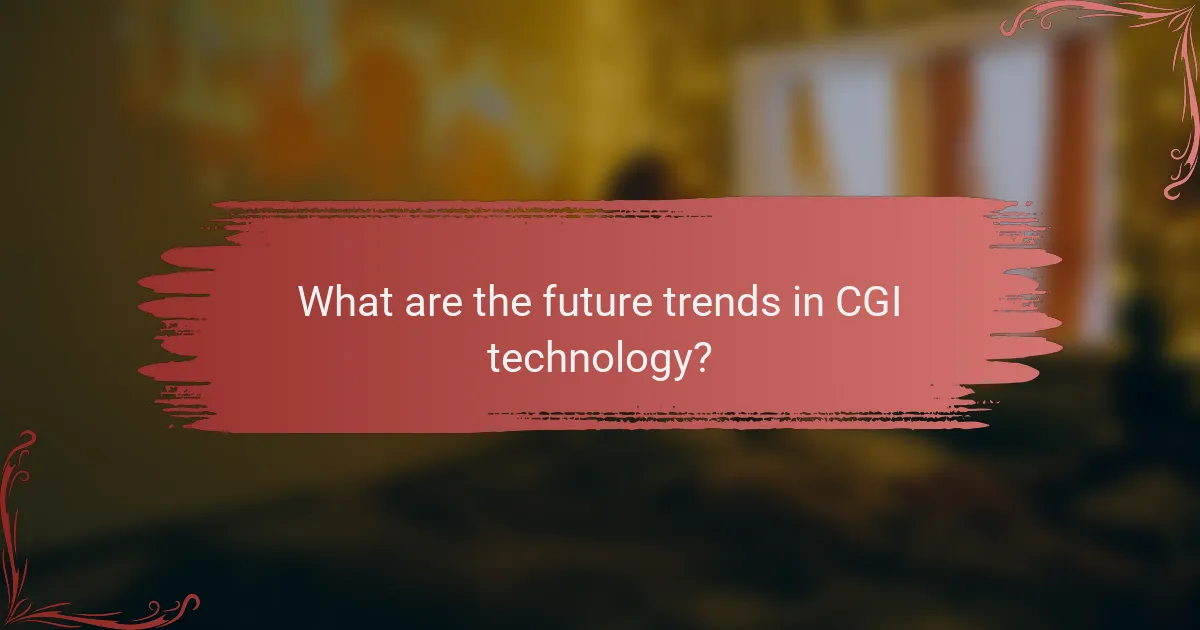Computer-Generated Imagery (CGI) is a pivotal technology in modern filmmaking, enabling the creation of visual content that enhances storytelling through intricate environments and realistic characters. Landmark films such as “Jurassic Park,” “Terminator 2: Judgment Day,” and “The Matrix” exemplify the transformative impact of CGI on cinematic visuals and narrative. This article explores the technological breakthroughs that have defined CGI, highlights key films that have set industry standards, and discusses future trends, including advancements in real-time rendering and artificial intelligence integration. The evolution of CGI continues to shape immersive experiences across various genres in film and beyond.

What is CGI and why is it significant in modern filmmaking?
CGI, or Computer-Generated Imagery, is the creation of still or animated visual content using computer software. It allows filmmakers to produce images and effects that would be difficult or impossible to achieve through traditional means. CGI plays a significant role in modern filmmaking by enhancing visual storytelling. It enables the depiction of fantastical elements, intricate environments, and realistic characters. Landmark films like “Jurassic Park” and “Avatar” showcase the transformative power of CGI. These films pushed the boundaries of what could be visualized on screen. CGI has become essential for creating immersive experiences in cinema. It supports various genres, from action to animation, making films more engaging for audiences.
How has CGI evolved since its inception?
CGI has evolved significantly since its inception in the 1960s. Early CGI was primarily used for simple animations and visual effects in films. The first notable use was in “Westworld” (1973), which featured a computer-generated character. By the 1980s, advancements in technology allowed for more complex graphics, as seen in “Tron” (1982), which integrated CGI with live-action footage. The 1990s marked a turning point with films like “Jurassic Park” (1993), showcasing realistic CGI dinosaurs. The advent of 3D modeling and rendering software further enhanced CGI capabilities. In the 2000s, films such as “Avatar” (2009) pushed the boundaries of realism and immersion in CGI. Today, CGI is a staple in filmmaking, used in almost every major production to create lifelike visuals and effects.
What were the early developments in CGI technology?
The early developments in CGI technology began in the 1960s. Researchers at universities and companies started experimenting with computer graphics. In 1963, Ivan Sutherland created the first computer graphics program called Sketchpad. This program allowed users to draw on a computer screen with a light pen. In 1972, the film “A Computer Animated Hand” by Ed Catmull showcased early 3D animation techniques. The 1980s saw the introduction of more advanced CGI in films. “Tron,” released in 1982, was one of the first films to use extensive CGI. By the late 1980s, CGI became more mainstream in the film industry. The release of “The Abyss” in 1989 featured groundbreaking CGI effects. These developments laid the foundation for modern CGI technology.
How did advancements in computing power influence CGI?
Advancements in computing power significantly enhanced CGI capabilities. Increased processing speed allowed for more complex rendering techniques. This led to the creation of more realistic textures and lighting effects. Enhanced memory capacity enabled larger and more detailed models. For instance, the introduction of GPUs revolutionized real-time rendering. Graphics processing units improved frame rates and visual fidelity in animations. Landmark films like “Jurassic Park” showcased these advancements effectively. The film featured groundbreaking CGI that was previously unattainable due to limited computing power. Overall, advancements in computing power directly shaped the evolution and quality of CGI in the film industry.
What are the core components of CGI technology?
The core components of CGI technology include modeling, animation, rendering, and compositing. Modeling refers to creating 3D objects using software like Autodesk Maya or Blender. Animation involves bringing these models to life through movement and expressions. Rendering is the process of generating the final image or sequence from the 3D models and animations. Compositing combines different visual elements from various sources into a single image. Each component plays a crucial role in the production of CGI in films and video games. These elements work together to create realistic and immersive visual experiences.
What software and tools are essential for CGI creation?
Essential software and tools for CGI creation include Autodesk Maya, Blender, and Adobe After Effects. Autodesk Maya is widely used for 3D modeling, animation, and rendering. Blender offers a free, open-source alternative with powerful features for modeling and animation. Adobe After Effects is crucial for compositing and visual effects. Other important tools include ZBrush for detailed sculpting and Substance Painter for texturing. These tools are industry standards, utilized in major films and video games, confirming their significance in CGI production.
How do different rendering techniques impact CGI quality?
Different rendering techniques significantly impact CGI quality by affecting realism, detail, and performance. Rasterization is fast and suitable for real-time applications but may lack depth. Ray tracing offers superior realism through accurate light simulation but is computationally intensive. Global illumination enhances light interactions, creating more lifelike scenes. Techniques like ambient occlusion add depth perception, improving visual fidelity. High dynamic range rendering captures a wider range of brightness, enhancing realism. Each technique’s choice influences the balance between quality and rendering speed. Therefore, selecting an appropriate rendering technique is crucial for achieving desired CGI outcomes.

What landmark films have defined the use of CGI?
Jurassic Park, released in 1993, is a landmark film that defined the use of CGI. It showcased groundbreaking visual effects that brought dinosaurs to life. The film integrated CGI with practical effects, setting a new standard for the industry. Another significant film is Terminator 2: Judgment Day, released in 1991. It introduced advanced CGI for the T-1000 character, influencing future action films. The Matrix, released in 1999, also revolutionized CGI with its iconic bullet-dodging scenes. These films demonstrated the potential of CGI in storytelling and visual effects. Their innovations paved the way for modern filmmaking techniques.
How did CGI transform storytelling in cinema?
CGI transformed storytelling in cinema by enabling the creation of visually stunning and imaginative worlds. It allowed filmmakers to depict scenes that were previously impossible to achieve. For example, films like “Jurassic Park” showcased realistic dinosaurs through CGI. This technology enhanced narrative possibilities, making stories more engaging. CGI also facilitated complex action sequences, as seen in “The Matrix.” The ability to manipulate digital environments gave directors greater creative freedom. As a result, CGI has become integral to modern filmmaking, influencing both audience expectations and industry standards.
What are some notable examples of CGI in iconic films?
Notable examples of CGI in iconic films include “Jurassic Park,” “Avatar,” and “The Lord of the Rings.” “Jurassic Park,” released in 1993, showcased groundbreaking CGI with realistic dinosaurs. This film set new standards for visual effects in cinema. “Avatar,” released in 2009, utilized advanced CGI to create an immersive 3D world. Its innovative technology earned it multiple Academy Awards. “The Lord of the Rings” trilogy, released between 2001 and 2003, featured extensive CGI to bring Middle-earth to life. It combined practical effects with digital enhancements. These films exemplify the evolution and impact of CGI in the film industry.
How did CGI contribute to the visual effects of specific genres?
CGI significantly enhanced visual effects across various film genres. In science fiction, CGI enabled the creation of realistic alien worlds and advanced technology. For example, “Avatar” utilized CGI to construct the lush environment of Pandora, revolutionizing visual storytelling. In action films, CGI facilitated dynamic sequences and stunts that were previously impossible. The “Transformers” series showcased CGI in animating complex robot transformations. Fantasy genres benefited from CGI by bringing mythical creatures to life, as seen in “The Lord of the Rings,” where CGI created realistic orcs and Gollum. Horror films used CGI to create unsettling visual effects, enhancing suspense and fear. “The Ring” employed CGI to depict the eerie Samara, intensifying the film’s chilling atmosphere. Overall, CGI transformed visual effects by allowing filmmakers to visualize their creative visions more vividly and realistically.
What role do directors and artists play in CGI production?
Directors and artists are crucial in CGI production. Directors oversee the overall vision and narrative of the project. They guide the creative direction and ensure that CGI elements align with the story. Artists, including 3D modelers, animators, and texture artists, bring the director’s vision to life. They create the visual components, including characters, environments, and effects. Collaboration between directors and artists ensures the integration of CGI into live-action footage or animated sequences. This teamwork is essential for achieving a cohesive final product. Successful CGI productions often result from effective communication and shared artistic goals.
How do collaboration and creativity shape CGI outcomes?
Collaboration and creativity significantly shape CGI outcomes by enhancing innovation and refining visual storytelling. Collaborative efforts among artists, technicians, and directors lead to diverse perspectives. This diversity fosters creative solutions to complex challenges in CGI production. For example, the film “Avatar” showcased groundbreaking CGI due to its collaborative environment among various teams. Creative brainstorming sessions often yield unique visual styles and techniques. These sessions encourage experimentation, resulting in visually stunning effects. Moreover, collaboration allows for more effective problem-solving during production. The integration of different skills and ideas leads to higher quality CGI. Ultimately, the synergy between collaboration and creativity is essential for achieving impactful CGI results.
What challenges do filmmakers face when integrating CGI?
Filmmakers face several challenges when integrating CGI into their projects. One major challenge is the high cost associated with CGI production. Complex CGI sequences can significantly increase a film’s budget. Additionally, integrating CGI requires advanced technical skills and expertise. Many filmmakers must collaborate with specialized CGI artists and technicians. This can lead to communication issues and creative differences. Another challenge is ensuring that CGI elements blend seamlessly with live-action footage. Inconsistent lighting and perspective can disrupt the visual coherence of a scene. Filmmakers also face time constraints, as CGI can be time-consuming to create and render. Finally, audience expectations can be a challenge. Viewers demand high-quality CGI that meets or exceeds industry standards. This pressure can lead to increased stress on the production team.

What are the future trends in CGI technology?
Future trends in CGI technology include advancements in real-time rendering and AI integration. Real-time rendering allows for immediate visualization during production. This enhances efficiency in filmmaking and gaming. AI integration aids in automating tasks such as animation and scene generation. Machine learning algorithms can create realistic textures and models. Virtual reality (VR) and augmented reality (AR) will increasingly utilize CGI for immersive experiences. Furthermore, cloud-based CGI solutions are expected to streamline collaboration among teams. These trends reflect the ongoing evolution of CGI in various industries.
How is artificial intelligence influencing CGI development?
Artificial intelligence is significantly influencing CGI development by enhancing automation and realism. AI algorithms streamline the animation process, reducing the time and effort needed for character movement and scene creation. Machine learning techniques enable the generation of realistic textures and environments, improving visual fidelity. AI tools assist in predictive modeling, allowing artists to visualize complex scenes more efficiently. Additionally, AI-driven software can analyze vast datasets to create more lifelike simulations of natural phenomena. For example, AI has been used in films like “The Lion King” (2019) to create hyper-realistic animal movements. Overall, AI’s integration into CGI is transforming the industry by increasing productivity and elevating creative possibilities.
What potential does machine learning hold for CGI animation?
Machine learning has significant potential for CGI animation. It can automate processes like character rigging and motion capture. This reduces the time and effort required for animators. Machine learning algorithms can analyze vast datasets to create realistic animations. For instance, they can learn from existing animations to generate new sequences. Additionally, machine learning enhances visual effects by improving rendering quality. Techniques like neural rendering can produce photorealistic images more efficiently. Recent advancements have shown that machine learning can also assist in storyboarding and scene composition. Overall, it transforms the animation workflow, making it more efficient and innovative.
How might real-time rendering change the future of CGI?
Real-time rendering will significantly enhance the future of CGI by enabling instantaneous visual feedback. This technology allows artists to see changes as they make them, improving workflow efficiency. Traditional rendering often requires long processing times, delaying creative decisions. Real-time rendering reduces this lag, facilitating rapid iterations during production. This shift will likely lead to more dynamic and interactive content. For instance, video games and virtual reality experiences will become increasingly immersive. The integration of real-time rendering into film production is already being explored. It allows filmmakers to visualize scenes in real-time, enhancing storytelling possibilities. Overall, real-time rendering represents a paradigm shift in CGI, fostering innovation across various industries.
What emerging technologies are impacting the CGI landscape?
Emerging technologies impacting the CGI landscape include artificial intelligence, real-time rendering, and virtual reality. Artificial intelligence enhances animation and character creation, making processes faster and more efficient. Real-time rendering technology allows for immediate visualization of CGI elements, significantly improving workflow. Virtual reality provides immersive environments, creating new opportunities for CGI applications. These technologies are reshaping how CGI is produced and experienced in films and other media.
How are virtual reality and augmented reality shaping CGI applications?
Virtual reality (VR) and augmented reality (AR) are significantly transforming CGI applications. VR immerses users in a completely digital environment. This allows for more interactive and engaging experiences in CGI content. AR overlays digital elements onto the real world. This enhances user interaction with CGI by blending it with real-life settings.
Both technologies enable real-time rendering of CGI. This increases the demand for high-quality graphics in applications. For instance, films like “Avatar” utilized VR and AR to create immersive visual effects. Studies show that VR can enhance storytelling by making viewers feel part of the narrative.
Additionally, AR is used in gaming, where CGI interacts with the physical environment. This creates a more dynamic user experience. Overall, VR and AR are pushing the boundaries of CGI, leading to innovative applications across various industries.
What trends should filmmakers be aware of for upcoming CGI innovations?
Filmmakers should be aware of several key trends in upcoming CGI innovations. Real-time rendering technology is advancing rapidly. This allows filmmakers to visualize CGI effects instantly during production. Machine learning is also being integrated into CGI workflows. It enhances animation and visual effects by automating complex tasks.
Another trend is the use of virtual reality (VR) and augmented reality (AR) in filmmaking. These technologies create immersive experiences for audiences. Filmmakers are increasingly adopting cloud-based CGI solutions. This enables collaboration across global teams more efficiently.
Additionally, there is a growing emphasis on photorealism in CGI. Innovations in texture mapping and lighting techniques contribute to this trend. Filmmakers are also exploring the use of digital humans in storytelling. This includes creating lifelike characters with advanced motion capture technology.
These trends indicate a shift towards more interactive and visually stunning cinematic experiences.
What best practices should filmmakers follow when using CGI?
Filmmakers should prioritize realism in CGI to enhance audience immersion. This involves matching the lighting and textures of CGI elements to the live-action footage. Consistent color grading is essential for seamless integration of CGI with real environments. Filmmakers must also pay attention to the physics of motion to ensure believable interactions between CGI and live actors. Utilizing high-quality models and textures improves visual fidelity. Collaborating with experienced CGI artists can lead to innovative solutions and better results. Regularly testing CGI in various scenes ensures that it fits naturally within the film’s context. Finally, balancing CGI with practical effects can create a more engaging experience for viewers.
How can filmmakers balance CGI and practical effects for optimal results?
Filmmakers can balance CGI and practical effects by integrating both techniques strategically. Using practical effects enhances realism and provides tangible elements for actors to interact with. CGI can then be applied to augment these effects, creating a seamless visual experience. For example, in “Jurassic Park,” animatronics were used for close-up shots, while CGI filled in the broader scenes. This combination allows for more believable interactions and environments. Filmmakers should assess each scene’s requirements to determine the best approach. A hybrid strategy often results in a more immersive audience experience. Balancing these methods can lead to innovative storytelling and visual impact.
What tips can enhance the integration of CGI into storytelling?
To enhance the integration of CGI into storytelling, focus on seamless blending with live-action elements. This involves using CGI to enhance, rather than overshadow, the narrative. Ensure that CGI elements are consistent with the film’s visual style. This maintains immersion for the audience. Prioritize character-driven CGI that supports emotional arcs. Engaging characters enhance the audience’s connection to the story. Collaborate closely between CGI artists and directors for cohesive vision. This collaboration ensures that CGI serves the story’s needs. Utilize practical effects alongside CGI for realism. Combining these techniques can create a more believable environment. Lastly, test audience reactions to CGI during development. Feedback can guide adjustments for better integration.
CGI, or Computer-Generated Imagery, is a pivotal technology in modern filmmaking that enables the creation of visual content through computer software. This article explores the evolution of CGI from its early developments in the 1960s to its transformative impact on landmark films such as “Jurassic Park” and “Avatar.” Key components of CGI technology, essential software, and rendering techniques are discussed, along with the challenges filmmakers face in integrating CGI into their projects. Additionally, the article examines future trends, including advancements in AI, real-time rendering, and the influence of virtual and augmented reality on CGI applications, providing a comprehensive overview of CGI’s role in shaping cinematic storytelling.
